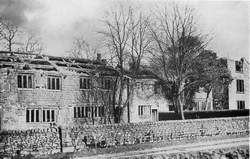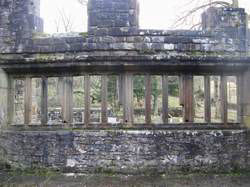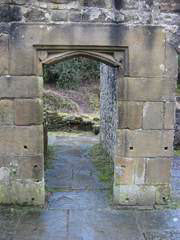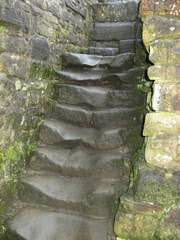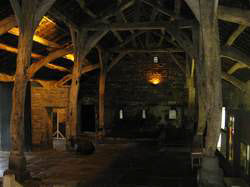Abandoned Communities ..... Wycoller
Some of the houses in the village date from the sixteenth century. In particular the largest building in Wycoller, Wycoller Hall, was erected around the middle of that century. Its early history is shrouded in mystery but it may have been built by Peter Hartley, one of many Hartleys who lived in Wycoller between the fifteenth and seventeenth centuries.
The information board now standing outside the ruins of Wycoller Hall suggests that the Hall went through six phases of building, the last two after Henry Owen Cunliffe inherited the Hall in 1773. Although it was gradually enlarged it appears that it always contained at least two dwellings. Most of the building had two storeys, but major alterations at phase 4 (some time before 1660) included a three storey extension at the southern end. A doorway on the east side of the main room in the Hall still has the date 1596 inscribed on spandrels above the arch. In 1596 that doorway may simply have led outside, but in phase 4 it became the entrance to a short passage leading into the new kitchen.
An excellent description of Wycoller Hall was published in the Victoria County History in 1911. I particularly like the brief paragraph mentioning the superstitious and other stories associated with the house. Note that the construction dates given in the VCH article differ from those on the information board at Wycoller Hall today.
Close to the ruins of Wycoller Hall there is a splendid aisled barn. It was probably built during the Tudor period. It is now an information centre, and panels inside it explain the techniques that would have been used in its construction. It is estimated that about 26 trees would have been used to create the timber frame of the building, which is divided into five bays and has an aisle on each side of the main central area.
Wills from the seventeenth century and the inventories with them show that some inhabitants of Wycoller were by then moderately wealthy. In his book John Bentley has reproduced part of the inventory of John Pearson, who died in 1695. John Pearson's furniture included tables, a long settle, and six chairs, and also a long case clock. A weaving loom was listed in the kitchen along with a meal ark and a store of beef and bacon. In a chamber over the milk-house there was a bed with curtains and fittings, a cupboard, two boxes, a little trunk, and a looking glass. John Pearson probably lived at Wycoller Hall, though his descendants gave their name to another house in the village, Pearson's Farm.
We can estimate the population of Wycoller from local registers of baptisms and deaths. A table in a MA dissertation by Barbara Dawson compares the numbers of baptisms and deaths of Wycoller residents for the periods 1599-1653 and 1780-1833. Baptisms rose from 69 to 299 and deaths from 50 to 77. The population rose from about 75 in 1660 to about 180 in 1760, and reached its maximum of about 350 around 1820.
The excellent dissertation by Barbara Anne Dawson, Wycoller: the History of an East Lancashire Hamlet, was submitted to the University of Lancaster in 1973. A copy of it can be read at Colne public library.
The rapid increase in population was due entirely to the expansion in weaving work in Wycoller. The local register of baptisms often recorded the occupation of the head of household. Of 108 heads of household listed between 1790 and 1833 84 were weavers and five others combined weaving with either farming or woolcombing. Other occupations listed at least once include gardener, hatter (three of them), mason, carpenter, coachman, collier, and (one) shoemaker/shopkeeper.
The information board now standing outside the ruins of Wycoller Hall suggests that the Hall went through six phases of building, the last two after Henry Owen Cunliffe inherited the Hall in 1773. Although it was gradually enlarged it appears that it always contained at least two dwellings. Most of the building had two storeys, but major alterations at phase 4 (some time before 1660) included a three storey extension at the southern end. A doorway on the east side of the main room in the Hall still has the date 1596 inscribed on spandrels above the arch. In 1596 that doorway may simply have led outside, but in phase 4 it became the entrance to a short passage leading into the new kitchen.
An excellent description of Wycoller Hall was published in the Victoria County History in 1911. I particularly like the brief paragraph mentioning the superstitious and other stories associated with the house. Note that the construction dates given in the VCH article differ from those on the information board at Wycoller Hall today.
Close to the ruins of Wycoller Hall there is a splendid aisled barn. It was probably built during the Tudor period. It is now an information centre, and panels inside it explain the techniques that would have been used in its construction. It is estimated that about 26 trees would have been used to create the timber frame of the building, which is divided into five bays and has an aisle on each side of the main central area.
Wills from the seventeenth century and the inventories with them show that some inhabitants of Wycoller were by then moderately wealthy. In his book John Bentley has reproduced part of the inventory of John Pearson, who died in 1695. John Pearson's furniture included tables, a long settle, and six chairs, and also a long case clock. A weaving loom was listed in the kitchen along with a meal ark and a store of beef and bacon. In a chamber over the milk-
We can estimate the population of Wycoller from local registers of baptisms and deaths. A table in a MA dissertation by Barbara Dawson compares the numbers of baptisms and deaths of Wycoller residents for the periods 1599-
The excellent dissertation by Barbara Anne Dawson, Wycoller: the History of an East Lancashire Hamlet, was submitted to the University of Lancaster in 1973. A copy of it can be read at Colne public library.
The rapid increase in population was due entirely to the expansion in weaving work in Wycoller. The local register of baptisms often recorded the occupation of the head of household. Of 108 heads of household listed between 1790 and 1833 84 were weavers and five others combined weaving with either farming or woolcombing. Other occupations listed at least once include gardener, hatter (three of them), mason, carpenter, coachman, collier, and (one) shoemaker/shopkeeper.
Two
Wycoller Hall around 1900
Mullioned window in the hall at Wycoller Hall. The reason for the missing sections at the lower end of the main mullions is not known.
Doorway leading to the kitchen
Staircase at Wycoller Hall
The aisled barn
